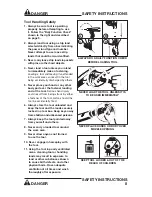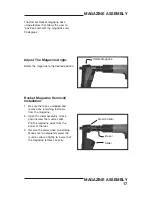
Preparation
Acceptable Base Materials
Powder actuated fastening is suitable for
use in the following base materials only:
• Poured Concrete
• Structural Steel
• Masonry Joints (see page 8)
Never attempt to fasten into any other
type of material.
Fastening into other
materials can cause blindness or other
serious injury.
Unacceptable Base Materials
Never attempt to fasten into very hard or
brittle materials such as cast iron, tile,
glass, or rock of any type.
These materials
can shatter, causing the fastener and/or base
material fragments to fly free and cause
serious injury to the tool operator and others.
Never fasten into soft base materials, such as
drywall or lumber products.
These materials
may allow the fastener to travel completely
through and out the other side, endangering
those in the path of the fastener.
Never fasten into any base material that
does not pass the Center Punch test.
Failure to assure the suitability of the base
material can result in serious injury to the
eyes or other body parts.
Center Punch Test
ALWAYS WEAR SAFETY GOGGLES
WHEN PERFORMING THIS TEST.
1. Always check the material being
fastened into for hardness before
attempting any fastening operation.
2. Using a fastener as a center punch,
strike the fastener against the work
surface using an average hammer
blow and check the results.
Center Punch Test Results
1. If the fastener point is flattened,
the material is too hard for a
powder actuated fastening.
2. If the fastener penetrates the
material easily, the material is
too soft.
3. If the material cracks or shatters,
the material is too brittle.
4. If the fastener makes a small
indentation into the material, the
material is suitable for fastening.
DANGER
SAFETY INSTRUCTIONS
SAFETY INSTRUCTIONS
DANGER
3
NEVER FASTEN INTO VERY HARD OR
BRITTLE MATERIALS
NEVER FASTEN INTO SOFT MATERIALS
SUCH AS DRYWALL




































